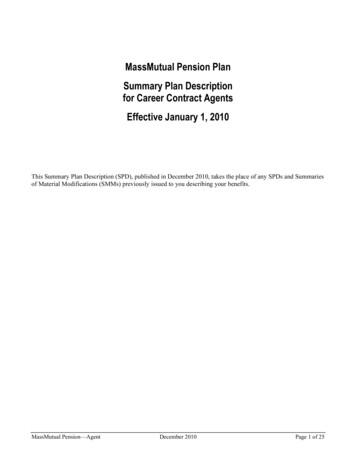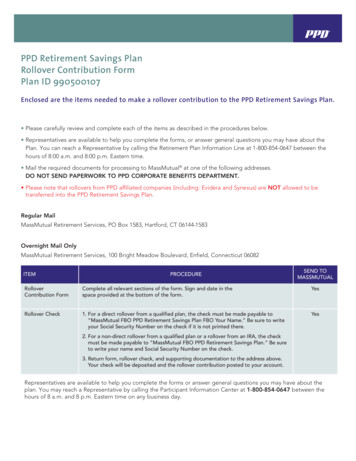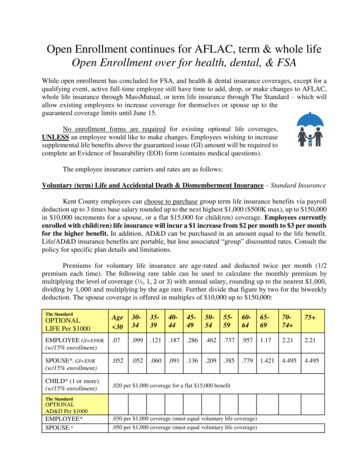
Transcription
A N OV E RVI EW GU I DEMassMutual CareChoiceSM OnePrepare for the possibilities — New YorkMassMutual CareChoice One (CareChoice One) is a single premium whole life insurancepolicy with riders that provide long term care benefits (LTC Riders).CareChoice One is issued by Massachusetts Mutual Life Insurance Company (MassMutual ).LI9029NY
People are living longer than ever.1 This means more years toenjoy retirement. However, living longer comes with a new setof challenges, including the possible need for long term care.MassMutual CareChoice One is a single premium whole lifepolicy that provides long term care benefits to help you preparefor life’s possibilities.CONTENTS1Paying for Long Term Care2CareChoice One — An Additional Way to Prepare3How CareChoice One Works — An Example5Prepare for Your PossibilitiesThe LTC Riders do not qualify for the New York State Long Term Care Partnership Program and are not Medicare supplementpolicies. The Accelerated Rider is not a health insurance policy and is not subject to the minimum requirements of New Yorklaw pertaining to long term care insurance.CareChoice One is a life insurance policy with riders that provide long term care benefits. It is appropriate for individualswho need long term care coverage and life insurance as a secondary benefit. CareChoice One offers individuals a way to helpprepare for their future long term care needs. You may want to consider additional coverage options as a way to meet all ofyour life insurance and long term care needs.The information provided is not written or intended as specific tax or legal advice. MassMutual, its subsidiaries, employeesand representatives are not authorized to give tax or legal advice. Individuals are encouraged to seek advice from their owntax or legal counsel.1National Vital Statistics Reports - Volume 65, Number 4, Centers for Disease Control and Prevention, June 30, 2016.NOT A BANK OR CREDIT UNION DEPOSIT OR OBLIGATION NOT FDIC OR NCUA INSURED NOT INSURED BY ANY FEDERAL GOVERNMENT AGENCY NOT GUARANTEED BY ANY BANK OR CREDIT UNION
Paying for Long Term CareMany people will need long term care (LTC) at some point in their livesdue to illness, injury or a severe cognitive impairment.Long term care refers to a variety of servicesto help meet personal care needs over anextended period of time. This often involvesnon-skilled assistance performing what arecalled the Activities of Daily Living.2LTC may take place in a nursing home orassisted living facility. However, people oftenchoose to receive care at home for as long aspossible, enabling them to remain connectedto their family and their community.Long term care is expensive and the costscontinue to rise. The rates for services varyfrom one region of the country to another. Ifyou need long term care at some point in yourlife, you may incur significant expenses. It’simportant to plan how you might pay for care.While you may need to rely onmultiple sources of funds, planningahead may help you receive thequality of care you want, in thesetting of your choice.2There are a number of ways to pay for LTC: Government Programs (Medicare/Medicaid) – Medicare provides limitedbenefits for long term care if it is partof a rehabilitative plan or skilled care.Medicaid will only pay for care onceyou meet eligibility requirements,including significant restrictions onincome and assets. Personal savings – Accumulatingadditional funds may be the simplestway to provide for the cost of long termcare. However, you may find it difficultto save enough. Traditional long term care insurance –Traditional individual long term careinsurance may be a cost-effective wayto ensure that a reliable source of fundswill be available to help pay long termcare expenses. However, some peopleare reluctant to pay for benefits theymay never need.If you need long term care at some point inyour life, you may need to rely on multiplesources of funds to help pay for the cost ofthese services. Planning ahead may help youreceive the quality of care you want, in thesetting of your choice, without compromisingyour standard of living in retirement.Activities of Daily Living include: bathing, dressing, using the toilet, transferring (to or from bed or a chair),continence and eating.1
CareChoice One — An Additional Way to PrepareCareChoice One is another way you can prepare for your futurelong term care needs. Regardless of how your future unfolds,CareChoice One gives you the flexibility to address life’s possibilitiespertaining to your long term care planning. If you need long term care CareChoice One provides a guaranteedpool of long term care benefits (LTCBenefit Pool) that becomes available topay monthly long term care benefits oncethe eligibility requirements and a 90-dayWaiting Period are satisfied. These benefitsare generally received income tax free.3 If you never need long term care CareChoice One is a whole life insurancepolicy that will pay a death benefit to yourbeneficiaries to help secure their financialfuture. The death benefit is guaranteedand is paid income tax free. If you have a change of plans CareChoice One provides competitiveguaranteed Policy Surrender Values(surrender values) that increase over time.This gives you the option to cancel yourpolicy for the surrender value at any time.4Policy Dividends —A CareChoice One AdvantageThe whole life policy is participating andtherefore eligible to receive dividends.5 Youhave the option to use your policy dividendsto purchase additional paid-up whole lifeinsurance, also called paid-up additions, whichwill increase your death benefit, surrendervalue and LTC Benefit Pool.Underwriting is necessary for both the lifeinsurance policy and the LTC Riders. A medicalexam is generally not required, but may benecessary in certain situations.Ideally, your long term careplanning strategy will havethe flexibility to adapt to yourchanging needs, allowing you tobe prepared for life’s possibilities.3 TheLTC Riders are intended to be federally tax-qualified long term care insurance contracts under Section 7702B(b)of the Internal Revenue Code, as amended. Therefore, any long term care benefits paid under the riders are generallyreceived income tax free and a portion of the premium paid for the riders may be deductible from gross income forfederal income tax purposes.Benefit payments received under the LTC Riders for Covered Services may be taxable if you receive benefit paymentsunder other long term care insurance coverage for the same services. You should carefully consider other long term carecoverage you may have before accessing benefits under the riders. Consult your tax advisor.4 MostCareChoice One policies will be Modified Endowment Contracts (MECs). If the policy is a MEC, policy loans and/or distributions from the policy (including dividends paid in cash and full/partial surrenders) are taxable to the extent ofgain and are subject to a 10% tax penalty if the policyowner is under age 59 1/2. In general, the only non-MEC CareChoiceOne policies are those primarily funded with a tax-free exchange of another non-MEC life insurance policy under InternalRevenue Code Section 1035.5 Dividends2are not guaranteed.
How CareChoice One Works — An ExampleMeet DanDan is 60 years old and planning to retire within the next five years. He has saved a substantial amount inhis retirement accounts and he has additional cash reserves of 300,000 in CDs and money market funds.Although Dan feels confident about his retirement strategy, he is concerned that if he ever needslong term care, the expenses could quickly deplete his savings. He considered buying individual LTCinsurance, but decided not to because he was reluctant to pay for benefits he may never receive.The CareChoice One AlternativeDan could use a portion of his cash reserves to purchase a MassMutual CareChoice One policy.Let’s take a look at the guaranteed benefits his policy provides:T H E C A R E C H O I C E O N E A LT E R N AT I V ECareChoice One Single Premium: 98,024DANN E E D S LT CDAN NEVERN E E D S LT CDAN’SPLANS CHANGE 300,000GuaranteedLTC Benefit Pool 150,000GuaranteedDeath Benefit 98,292 GuaranteedPolicy Surrender Value(End of year 9) Dan’s premium buys 150,000of Base Benefit Amount(the amount of guaranteeddeath benefit available foracceleration) and 150,000 ofExtended LTC Benefit. If Dan needs long term care,he can receive up to 6,250per month for a minimum of48 months. Dan’s LTC benefits wouldreduce his death benefit firstand then his ExtendedLTC coverage. Any dividends paid couldincrease LTC benefits. If Dan doesn’t need long termcare, his beneficiaries willreceive a death benefitof 150,000. Dan can cash in his policy forthe surrender value if hisplans change. The surrender value at the endof the first year is 76,562.After nine years, the guaranteedsurrender value will growto 98,292. The surrender value will beadjusted for benefits paid,loans and/or withdrawals. Dividends paid could alsoincrease the surrender valueof the policy. If Dan accelerates only aportion of his CareChoice Onedeath benefit to pay long termcare expenses, the remainingdeath benefit would goto his beneficiaries. Dan could choose to usedividends to increase thedeath benefit payable.Example based on a CareChoice One policy, male, issue age 60, Non-tobacco, 150,000 policy face amount.MassMutual CareChoice One offers an inflation protection option that increases the LTC Benefit Pool andMaximum Monthly Benefit by a 5% annual compound rate each year. This example assumes that the inflationprotection option was not elected.3
How CareChoice One May Help DanDan’s CareChoice One policy gives him the flexibility he needs in retirement and reduces someof the uncertainty of how he will pay for long term care if he needs it. His policy provides thefollowing advantages: He is able to leverage a portion of hissavings to create a substantially largerLTC Benefit Pool. If Dan never needs long term care, thepolicy provides a guaranteed deathbenefit and surrender value. It may allow him to use his remaining 201,976 of cash reserves forother purposes. Any dividends Dan receives could beused to purchase additional paid-upwhole life insurance, increasing hispolicy death benefit, surrender valueand LTC Benefit Pool over time.Dividends are not guaranteed The long term care benefits may helpprotect his other retirement assets andincome from being depleted by longterm care expenses.Dividends could significantly increase the benefitsof Dan’s CareChoice One policy over time.4
Prepare for Your PossibilitiesCareChoice One offers attractive guaranteed benefits and thepotential to earn dividends.It can help you address your long term careprotection needs and become an importantpart of your overall retirement strategy.Your financial professional can provide a policyillustration based on your specific needs tohelp you determine if a CareChoice One policymakes sense for you.Ask your financial professional about using a CareChoice Onepolicy to begin preparing for your possibilities today.5
MassMutual.Helping you secure what matters most.Since 1851, our business decisions have been guided by our customers’needs. Today, we offer a wide range of financial products and services tohelp people secure their future and protect the ones they love.Learn more at www.MassMutual.comThe purpose of this material is the solicitation of insurance and an agent may contact you.Single Premium Whole Life insurance (SPWL-2013, SPWL-NY-2019, ICC13SPWL and ICC13SPWL in North Carolina) is aparticipating, permanent single premium life insurance policy issued by Massachusetts Mutual Life Insurance Company,Springfield, MA 01111-0001.For costs and further details of LTC Rider coverage, including exclusions and reductions or limitations, contact your agent/producer or MassMutual at 800-272-2216 for a referral to an insurance agent/producer. 2019 Massachusetts Mutual Life Insurance Company (MassMutual ), Springfield, MA 01111-0001.All rights reserved. www.MassMutual.com.LI9029NY 1019CRN202104-179627
Example based on a CareChoice One policy, male, issue age 60, Non-tobacco, 150,000 policy face amount. MassMutual CareChoice One offers an inflation protection option that increases the LTC Benefit Pool and Maximum Monthly Benefit by a 5% annual compound rate each year. This example assumes that the inflation protection option was not elected.










